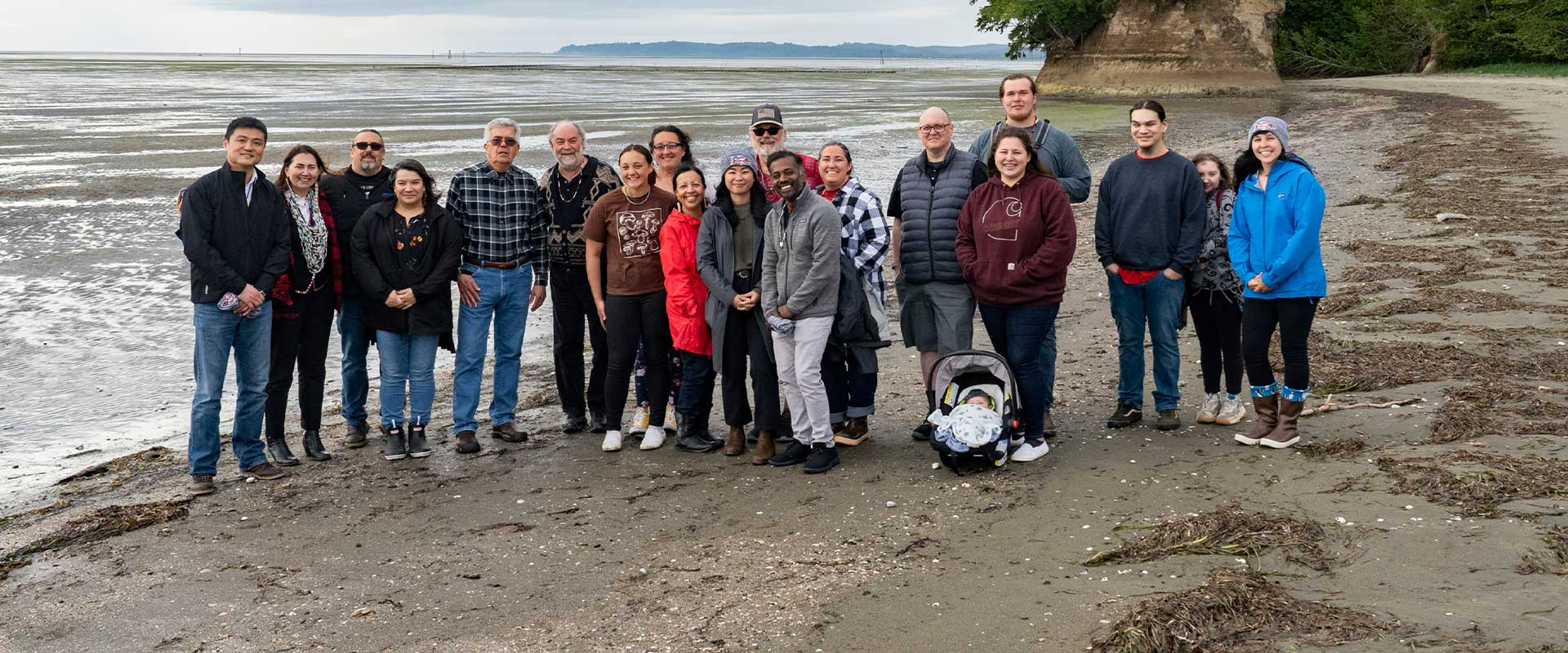
Funding | 2022 Grantmaking Report
A YEAR OF CHANGES,
but one thing remains the same
Published
September 2023
I’M PROUD TO SHARE Inatai Foundation’s 2022 Grantmaking Report, which chronicles our progress and the story of our third full year of grantmaking. Since 2019, we have committed a total of $200 million to hundreds of organizations in Washington state. We achieved our full grantmaking capacity last year, contributing nearly $64 million to powerful communities fighting for equity and racial justice in every corner of our state.
2022 was a year of evolutions, a series of changes to better reflect who we are today and who we aspire to be in service to grantee organizations. We clarified our values to help us play our best role as a foundation. We introduced a new mission statement: to transform the balance of power to ensure equity and racial justice across Washington and beyond. And we sought and received permission from the Chinook Nation to use the Chinuk Wawa word inatai as our new name. Inatai means “across” or “other side” and communicates our belief that powerful communities working together will move all of us to a place of greater equity and racial justice.
One thing that has not and will not change is who we support. Consistent with previous years, most of our grants in 2022 went to organizations led by and for people most affected by inequities and injustice. Their work impacts all 39 Washington counties. In our history as a foundation to date, more than 80 percent of the organizations we fund are led by Black, Indigenous, and people of color. Our worldview is straightforward: Equity and racial justice are not possible without communities having the power to determine the policies, institutions, and structures that affect their daily lives.
We have made the conscious choice to collect and report data that will help us make decisions in alignment with our values and mission and with communities’ visions for the future. This information also helps us hold ourselves accountable to being a truly statewide organization. As you dive in, we’d like to share three themes from our 2022 data that show how we can best support grantee organizations.
Expansion of multiyear grants
Ask any leader of a nonprofit and they will tell you that the best way for a funder to sustain the long-term work of equity and racial justice is through multiyear grants. Inatai also favors this approach because it allows us to build trusting relationships with organizations and more time to understand the communities they serve. To date, 60 percent of our grant dollars have been multiyear commitments. As leaders have shared with us time and again, the issues their communities face outlive the news cycle. Multiyear grants are necessary for the decades it takes to effectively strategize and organize.
Deeper investment in 501(c)(4) work
While all nonprofit organizations can participate in the electoral and political process to some extent, 501(c)(4) organizations are allowed greater latitude to pursue a range of advocacy, power-building, and political activities. In 2022, 20 percent of Inatai’s grant dollars were directed to 501(c)(4) organizations. As a 501(c)(4) organization, we prefer to make grants to reflective, accountable, community-rooted 501(c)(4) organizations. Our average grant to a BIPOC-led 501(c)(4) organization is significantly larger than the average grant to a 501(c)(3) nonprofit. Inatai resources have supported many organizations to expand their policy and advocacy work, including hiring political directors, organizers, and lobbyists.
Our systems and processes could use refining
A third-party evaluation of how grantee organizations experience our foundation showed that while people appreciate our approach to grantmaking and our emphasis on trust and relationship-building, we have room to improve how we communicate our grantmaking cycles and opportunities, so their structure and expectations are clearer to organizations seeking funding. In response, we invested time and energy into improving our internal processes and infrastructure, and we hope the organizations we support feel the payoff of that effort. As we continue to develop funding programs and strengthen our capacity, we will keep the experiences of organizations and leaders at the forefront of each decision we make.
On behalf of every team member at Inatai, we enjoyed getting to know you in 2022 and we look forward to even more connection ahead. Until then, we hope you find this report helpful in understanding our work, including areas we are striving to improve. Thank you for reading.


Nichole June Maher
President & CEO
2022 Highlights
$63.8M Total Grantmaking
Grants and contributions
%
to people-of-color-led organizations
%
as unrestricted grant awards
tribal nations awarded
unique organizations
convenings to connect with prospective and current grantees
GRANTEE ORGANIZATIONS ARE RACIALLY DIVERSE
Why we ask organizations for their racial identities
The lack of reflective leadership in institutions and government has prevented Black, Indigenous, and people of color from making decisions and shaping policies that impact their communities. Many BIPOC leaders we’ve met across the state also shared that their advocacy work—especially in rural areas and smaller cities—is often overlooked by philanthropy.
Inatai Foundation is accountable to people, organizations, and networks who are building power within racially diverse communities and who understand that racial justice is a core condition of equity. We ask grant applicants to share the racial identities of their leaders, as well as their organization’s identity, based on the definitions we offer as part of the process. We do not accept applications from organizations that decline to share this information, nor will we make grants to organizations that misrepresent themselves.
We are also learning other ways leaders reflect the communities they serve. Our team looks at several leadership identities in addition to race and ethnicity, including gender and gender expansiveness, abilities/disabilities, immigration status, sexuality, homelessness, and other lived experiences. As we continue to improve our data collection systems and processes, we hope to better understand how leaders within the organizations we support are connected to the communities they serve, and how we can best support their progress in becoming more racially and ethnically diverse.
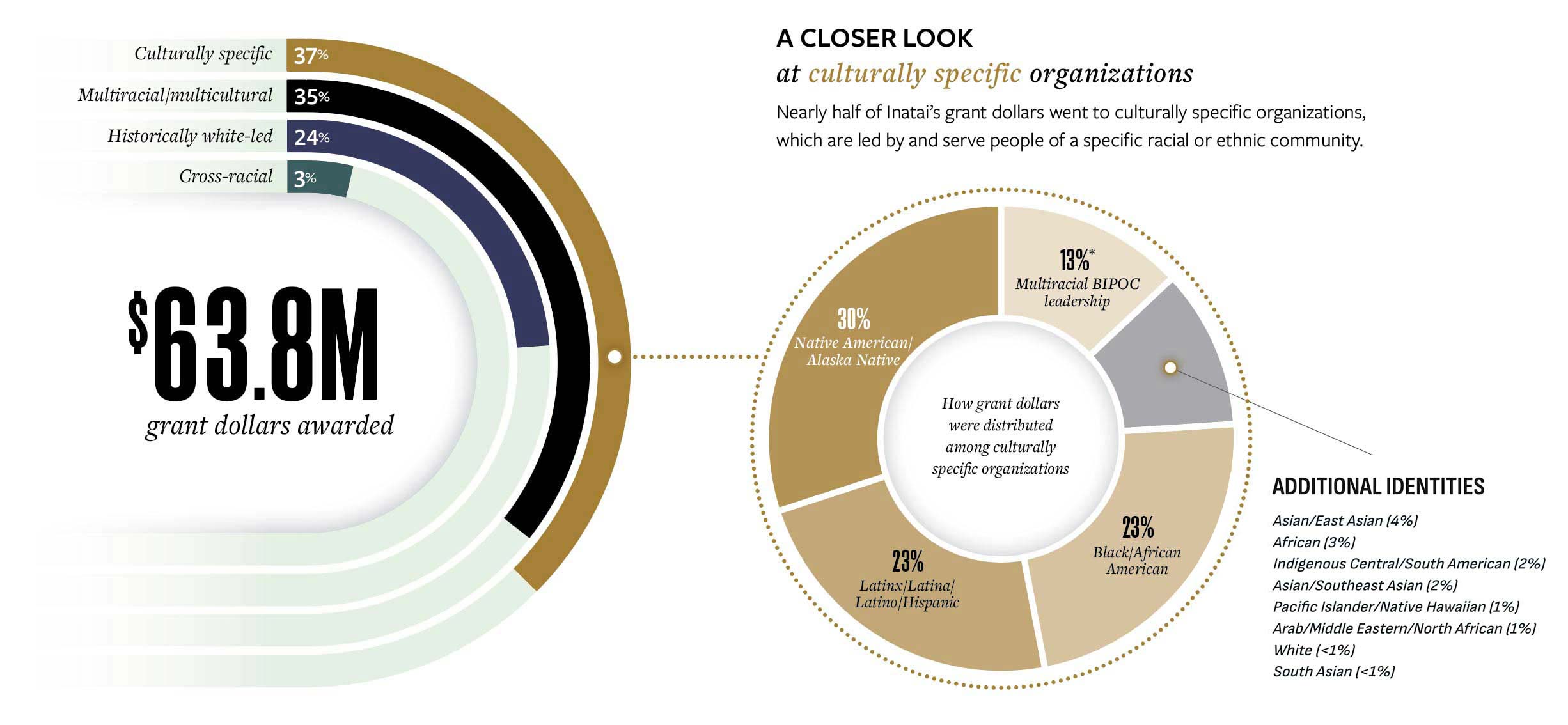
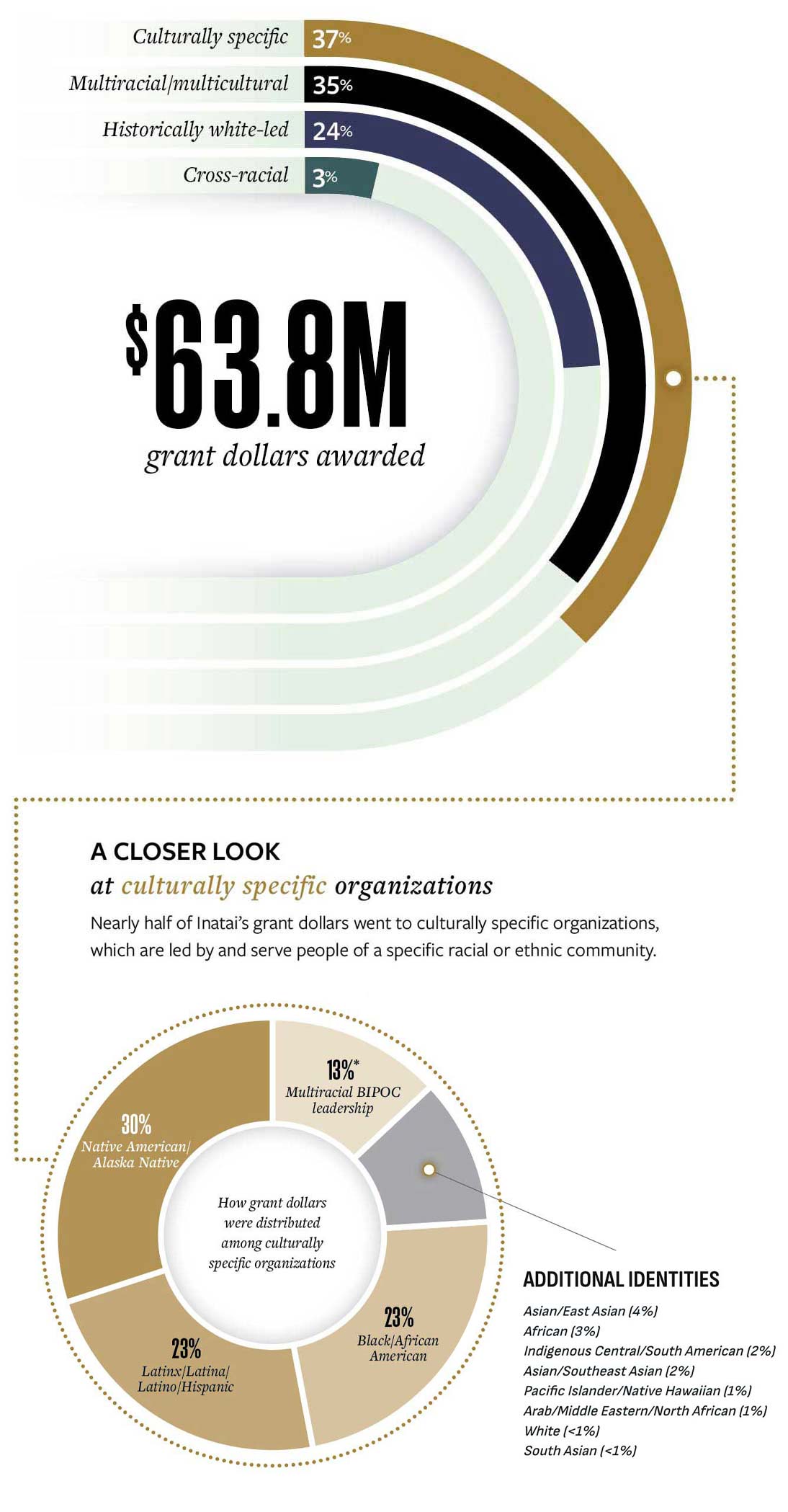
GRANTMAKING BY
ORGANIZATION IDENTITY
Culturally specific organizations are created by and for people of a specific racial or ethnic identity group and are accountable to that community.
Multiracial or multicultural organizations have leaders from several racial or ethnic identities.
Historically white-led organizations are founded, formed, goverened, and have cultures and values primarily led by white people.
Cross-racial organizations are coalitions or networks of groups, each with a specific racial, ethnic, or multicultural base. They come together to advance political, policy, or other priorities.
Note: 1 percent was awarded to organizations that did not fit into any of these categories.
A NOTE ABOUT AAPI ORGANIZATIONS
At the request of Native Hawaiian and Pacific Islander grantee leaders and organizations, we have begun to disaggregate the AAPI (Asian American and Pacific Islander) racial category into four different groups in our data collection. In this report, we count organizations with multiple Asian or Pacific Islander identities as multicultural or multiracial.
POWERFUL COMMUNITIES ARE EVERYWHERE
Grant Dollars awarded
by county
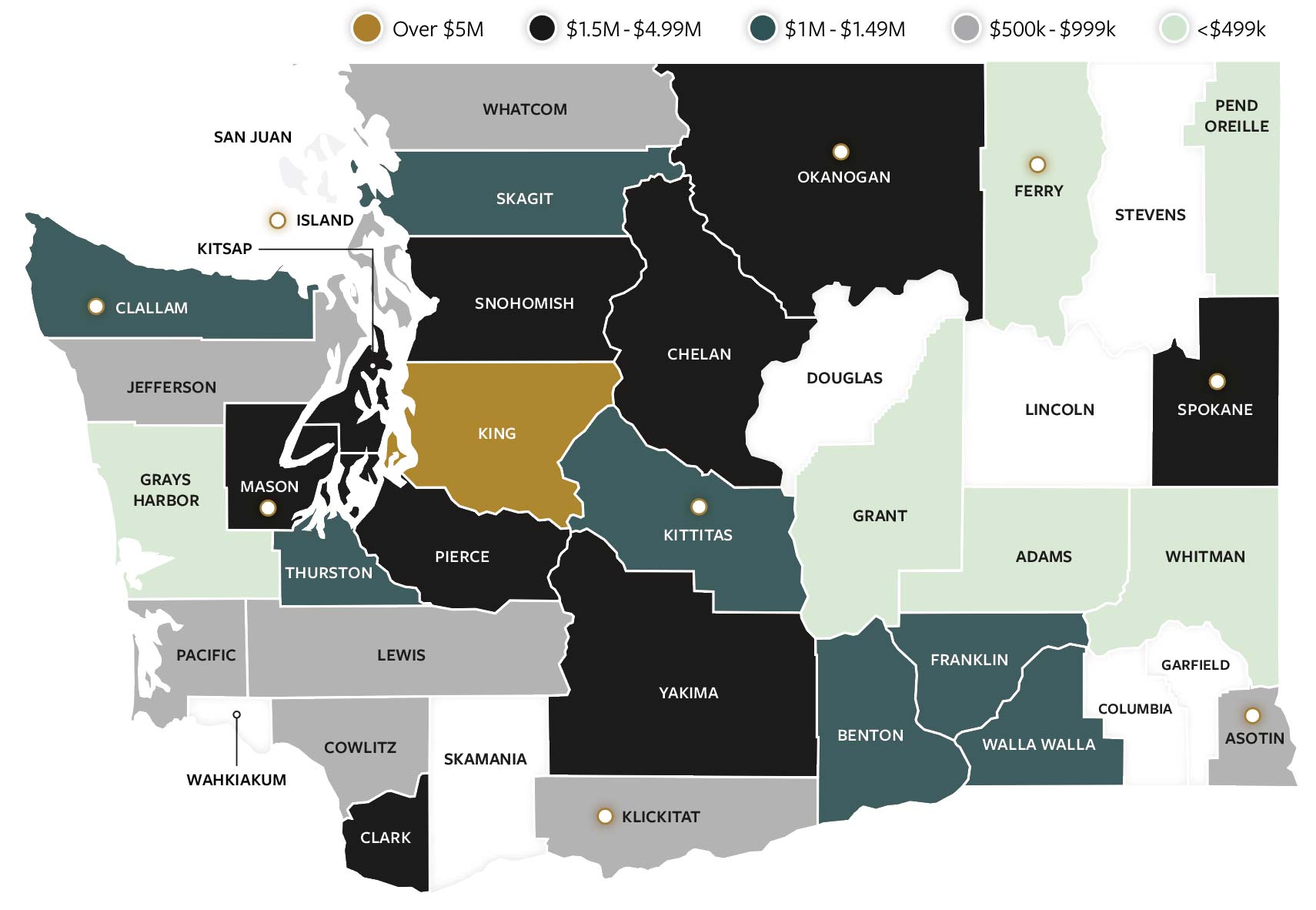
We understand that Washington is complex and diverse, and we are continually learning and trying to establish a more accurate picture of the geographic diversity in our region. As a foundation that strives to be truly statewide, Inatai asks organizations to identify the primary county(ies) in which they work.
We are also seeking to understand how applicants define their geography. The scale of grantees’ work ranges from local to statewide and even international in some cases. This information gives us an idea of where our resources are going and where we could be more geographically equitable.

AVERAGE GRANT SIZE BY COUNTY
In areas where we have found fewer organizations to fund, we are making larger grants to help bridge the gap. For reference, our average grant size per county is $93,000.
Asotin County – $670,000
Kittitas County – $219,000
Ferry County – $201,000
Mason County – $174,000
Clallam County – $170,000
Island County – $150,000
Klickitat County – $147,000
Okanogan County – $141,000
Spokane County – $129,000
Additionally, organizations whose work is truly rooted throughout the state received an average of $186,000.
SUPPORT OUTSIDE OF WASHINGTON
About 8 percent of our dollars were directed to out-of-state organizations who support multicultural and culturally specific legal advocacy, political organizing, voter engagement, and voter protection work that impacts communities in our state. About one-third of these funds remained in the Pacific Northwest, in neighboring states.
COMMUNITY POWER CANNOT BE BUILT IN ISOLATION
Community power cannot be built in isolation, so Inatai prioritized connecting grantee organizations in 2022. Our gatherings are active spaces where leaders can build upon their collective strengths and form genuine relationships based on shared identities, common goals, mutual priorities, and regional proximity.
This past year, Inatai Foundation continued to refine how we invited community leaders into shared space. Six of our eight convenings were designed around specific grantmaking programs and yielded invaluable lessons for how we understand community power building in the state.
EMERGING OPPORTUNITIES CONVENINGS
A series of in-person and virtual gatherings brought leaders from across the state to discuss and expand on four themes that have emerged in our history of grantmaking.
Executive transitions
Leaders from eight organizations joined a virtual discussion in June to talk about executive transitions at their organizations. Some were people of color taking over nonprofits that were historically white-led and others were founders who are planning for succession. A vital lesson is that when moving through key leadership changes, organizations benefit from technical assistance around leadership development, organizational sustainability, and infrastructure.
Immigrant justice
At an in-person gathering in Snoqualmie, 20 leaders from across the state working on immigrant justice shared stories of how policy and advocacy are essential to creating impactful changes for their communities. We clearly heard the need for statewide power-building infrastructure; our team was surprised when participants shared that this event was likely the first time a funder organized a statewide gathering for immigrant justice organizations.
Civil rights and legal advocacy
In Leavenworth, we brought together representatives from 12 organizations working to protect and advance civil rights in their communities. The organizations ranged from newer groups in smaller communities formed in reaction to far-right threats to large legal advocacy organizations with statewide reach. Still, there were areas where their work intersected, including common oppositional forces.
Wealth and asset creation
Our team invited leaders from 10 organizations to meet virtually and share their work with each other related to the development and protection of community-owned wealth. Participants saw wealth and asset building through various prisms, but all agreed that community-owned property and land lend significant strength to their communities.
SYSTEMS CHANGE CONVENING
Systems Change Grants (formerly known as Systems, Power & Action grants) are three-year awards totaling up to $720,000 for each recipient. As of fall 2022, this portfolio supports 73 organizations across the state to strengthen their power-building, advocacy, and systems change work. Last year, we held a virtual conference with 70 leaders from across Washington to connect, share, learn, and deepen their understanding of each other’s work and priorities. Leaders articulated their visions for expanding power-building strategies through voter engagement, public policy, and reflective leadership in government. Participants presented sharp analyses of what change looks like in their communities. Notably, many leaders committed to coordinating and supporting each other’s work after the event.
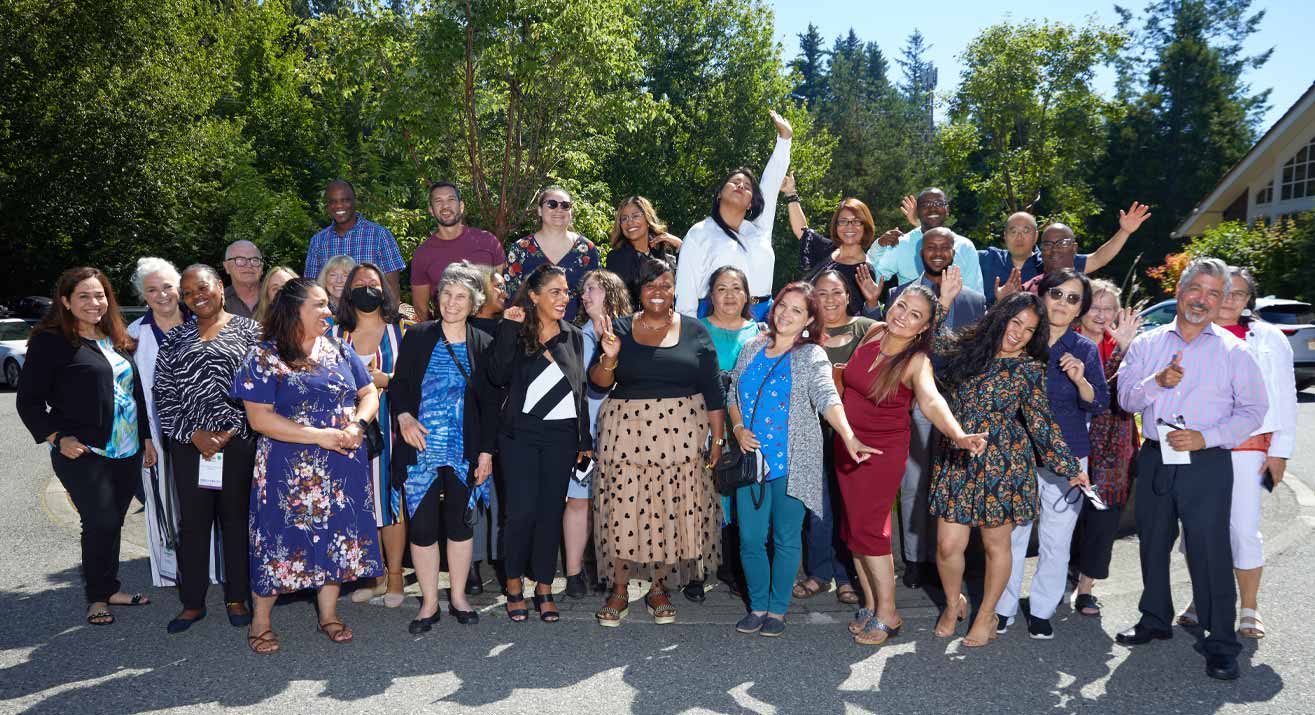
Community leaders and the Inatai team in Snoqualmie celebrating a convening of immigrant justice organizations from across the state.
Photo: Uly Curry
We’d like to thank the leaders of community organizations at the forefront of critical work who took time to connect with peers in our state.
Our next iteration of gatherings will center around different geographies, and we may uncover new opportunities for grantee organizations to dream and plan together. Ultimately, our hope is that participants from current and future grantee organizations continue to cultivate and sustain supportive relationships that lead to transformative power.
